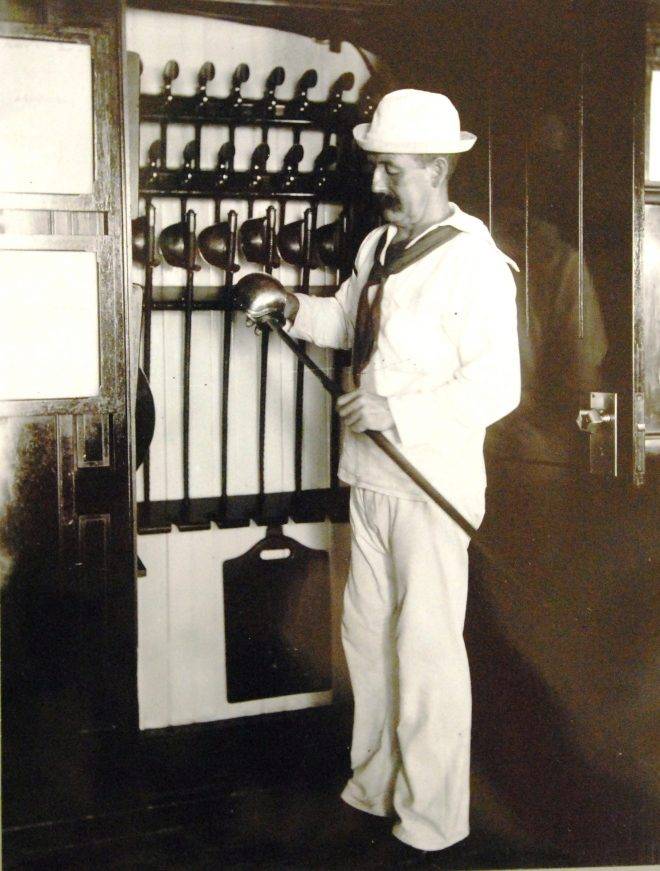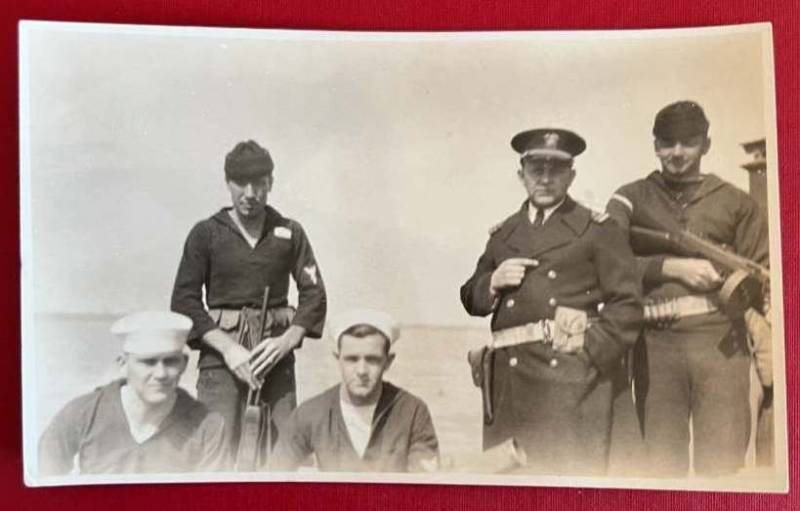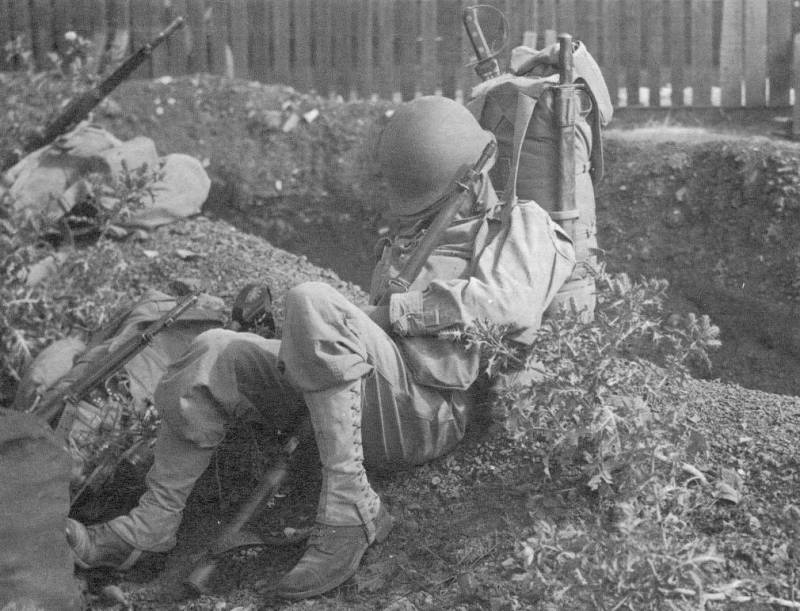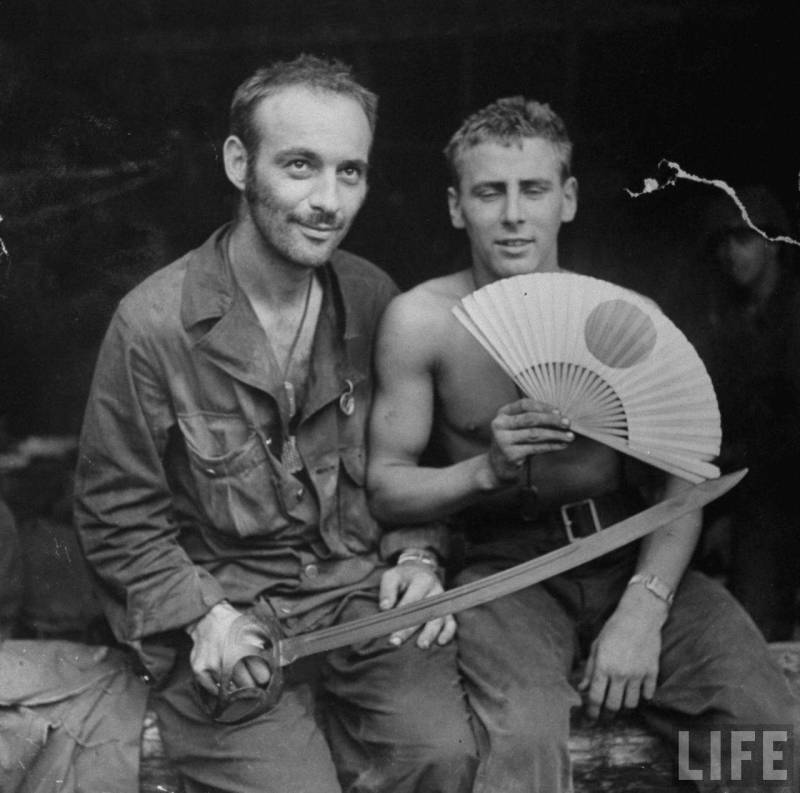Dutch klewang of the American fleet in the jungles of the Solomon Islands

American sailor with a cutlass in his hands at the cabinet with weapons boarding team of the US Navy cruiser Olympia, 1899.
Any fleet is strong in its traditions. True, it is sometimes very difficult to feel the fine line where tradition turns into inertia.
The American Navy, like, in fact, probably, any fleet in the 1860th century, was armed with a cutlass cutlass. In 1917, the rough cutlass was replaced by a more elegant cutlass of the classic "French" design, and with this weapon the US Navy entered the 1917th century with confidence. In 1860, when it became clear that the fleet would now grow rapidly in numbers, with the country's entry into the Great War, a cutlass of the XNUMX model appeared, which differed little from the XNUMX model, and the old model remained in service.
The First World War ended, the 1920s passed, the 1930s are in the yard, and the fleet still has boarding sabers as weapons in service and is not going to abandon them. In 1938 comes out naval manual on the actions of boarding teams, and it still describes the actions of sailors with cutlasses.
At the same time, the US Navy in the interwar period had the opportunity to understand that long-bladed edged weapons were disappearing into oblivion. There was a place where in the 1920s and 1930s the sailors of the US Navy had to take up arms, and then the last thing they thought about was cutlasses.
We are talking about US Navy patrols on the Yangtze River in China. On special patrol ships built in shipyards in China itself, American sailors provided navigation on the river, protected European traders and missionaries, and indicated the presence of American military forces in China. China at that time was a turbulent place, and American sailors in China had combat experience. Well, when it came to the “fight”, pistols, rifles, automatic rifles, submachine guns, machine guns were used ... Even wooden clubs and bayonets in places, but not sabers.
By the way, an interesting point, the Navy and Marine Corps were pioneers in the use of Thompson submachine guns in the US armed forces, ahead of the US Army in this matter, but more on that another time.

Photo from a private collection, boarding crew of the Guam patrol vessel, China, 1930s. The photo shows a Thompson submachine gun, a BAR automatic rifle and, below, a Mk. VI (US Navy designation for a Lewis machine gun).
And then December 1941 comes, the United States is already entering the Second World War and, as in 1917, naval commanders, realizing that the fleet will grow, are puzzled by the order of cutlasses. And then they run into problems. The search for a contractor turns into a disaster. The US Navy and Army are missing a lot, a lot, all manufacturers are simply drowning in army orders, missing deadlines, not having time to develop resources, etc.
Finding new contractors who have not previously dealt with long-bladed weapons is also not helpful, since they need time to reconfigure production and reconfigure capacities.
This is where the American manufacturer Milsco Manufacturing pops up, which has been making cutting sabers for almost two years now. True, not cutlasses, but Dutch klevangs, and not for the US armed forces, but for the Royal Dutch East Indies Army. But the weapons are similar in dimensions and characteristics, the manufacturer already has the capacity, and most importantly, the stock of finished products that were not shipped to the customer due to the start of the war. Well, the problem seems to be solved...
But then one of the naval chiefs suddenly says - it's 1942 in the yard, what cutlasses, klevangs, give up this business, firearms, and that's it. And although officially the cutlasses were removed from the supply of the American fleet only in 1949, in fact it was only a decision written on paper, made back in 1942 - the cutlasses were removed from the US Navy.
And this is where it ends story cutlasses of the US Navy ... and the history of the cutlasses of the US Army begins.
1942 was a year of growth problems for all structures of the US armed forces. Someone lacked a lot, someone just, some services were created in fact from scratch. What for one became old rubbish, for another it could be urgently needed. And now the US Army, which was soon to face Japanese soldiers in the jungles of the Solomon Islands, lacked such a simple thing as a machete. It seems to be an easy-to-manufacture tool, almost a garden one, but the units should sail overseas almost tomorrow, respectively, the machete is needed today.
Here, under the arm of army supplies, the Dutch klevangs decommissioned by sailors turned up. Yes, this was a forced, temporary measure, and American soldiers did not go en masse into the jungle with boarding sabers, but still, the first units of the 23rd Infantry Division of the US Army, sent to the Pacific theater of operations, received Dutch klevangs instead of machetes, rejected by the US Navy .

Private Taylor of the 182nd Regiment, 23rd Infantry Division dozes while waiting to be loaded onto a transport, November 1942. Dutch klevangs are visible on his backpack and next to him.
Later, during the liberation of the territories occupied by the Japanese, the Americans again encountered the Dutch klevangs. True, this time they were former klevangs of the Royal Dutch East Indies Army, which the Japanese got in 1941-1942 as trophies. The Japanese used these sabers both in their original form and in the “modernized” one, with the protection for the hand removed (“basket”, and in this case “half-basket”).

Photo from Life magazine February 1943, in which American infantrymen display trophies captured during the battles for the village of Buna in January 1943. One soldier holds a Dutch klevang freed from Japanese captivity.
The Dutch klevangs themselves quickly disappeared from the American infantry units. But the soldier's rumor about them remained. But since no one dedicated the infantrymen to the ups and downs of searching for an ersatz machete by army supplies, the soldiers themselves figured out the story of the appearance of their sabers.
As a result, the story circulated in the US Army for a long time that the first army units that went to fight in the Pacific Islands were equipped with shortened former cavalry sabers. Such an unexpected addition to the intricate story of the Dutch-American cutlass klewang, which ended up in the infantry.
Information